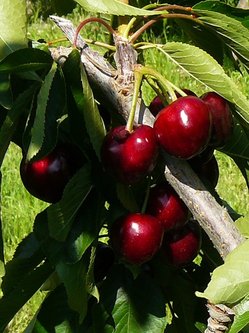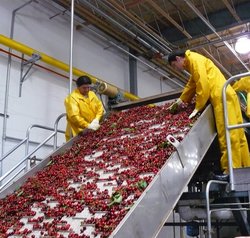 Washington grows two-thirds of the nation's sweet cherries on 35,000 acres of orchards, many on the sunny hillsides of the picturesque Yakima Valley. The cherries hang in clusters, and once they're picked they have to be declustered. That's the job of a big machine (known to the staff as the cluster-unf**ker) at Sage Fruit Company on the valley floor in Wapato.
Washington grows two-thirds of the nation's sweet cherries on 35,000 acres of orchards, many on the sunny hillsides of the picturesque Yakima Valley. The cherries hang in clusters, and once they're picked they have to be declustered. That's the job of a big machine (known to the staff as the cluster-unf**ker) at Sage Fruit Company on the valley floor in Wapato.
After the coolest spring on record, the six-week cherry season is finally getting underway, and the state's 2,500 cherry growers rely on packing houses like Sage to process the state's crop with computerized efficiency. A quarter gets exported (to China, Taiwan, Japan, Hong Kong) the rest goes to grocery stores around the country, promoted by the Washington State Fruit Commission (peaches, plums, nectarines, apricots...and cherries), a state agency funded by a levy on shipments.
 Up on the slopes, new varieties are coming online, allowing (theoreticallyl) for 800 dwarf trees per acre compared to 250 conventional trees. This means higher yields: 7 tons to the acre is the new target. Marc Hanrahan, one of the most technologically advanced growers, farms 140 acres above Mabton, producing 600 tons of cherries. To polinate the trees, he rents beehives, two per acre at $38 per box, for a three-week period in early spring.
Up on the slopes, new varieties are coming online, allowing (theoreticallyl) for 800 dwarf trees per acre compared to 250 conventional trees. This means higher yields: 7 tons to the acre is the new target. Marc Hanrahan, one of the most technologically advanced growers, farms 140 acres above Mabton, producing 600 tons of cherries. To polinate the trees, he rents beehives, two per acre at $38 per box, for a three-week period in early spring.
The current crop won't hit local stores until next week since air shipments to Asian markets have first dibs, although Safeway did have a $1.99 per pound special over the Father's Day weekend. (Early cherries often sell for three times that much.)
That packing line at Sage, by the way, can handle 20 tons of fruit an hour; there's 150 hardworking people on the floor every shift. It costs orchard owners at least 30 cents a pound to grow the cherries, and Sage charges them another 50 cents a pound to do all that cluster-cutting, sorting and packing, then adds more for shipping and marketing. (Those $1.99 cherries, breakeven at best.) There are gas-filled, temperature controlled warehouses that make it possible to store apples, to name just one fruit, for year-round sale. On the other hand, "Cherries are one of the few remaining item that have a true seasonality," says Robb Myers, a member of the Fruit Commission, "and that really helps with the consumer demand."
Leave a comment